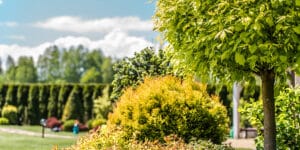By: Shelby McCullough| Published: November 7, 2022
Do you need help choosing the best trees and knowing where to plant them? Call McCullough Tree Service at 407-734-5854 for expert help.

Adding trees to your property serves both aesthetic and practical purposes. Not only do trees enhance the landscape, but they also provide some shade from the hot Florida sun.
Choosing fruit trees provides your family with a supply of fresh food. What’s better than some fresh citrus or mangoes picked right in your backyard?
When choosing trees, selecting appropriate tree species is only the beginning. The right spacing of trees and between plants and other structures also matters. Careful planning for tree planting prevents damage and preserves tree health.
Researching the best deciduous trees for your Orlando home can help narrow your choices. This homework includes learning the space requirements for each tree and whether your yard can accommodate them. As experts in tree Service in Orlando, FL, we have some guidelines for you to consider when choosing landscape trees.
Tree Planting Tips for Homeowners
When planting trees in your yard, the most important thing to remember is that they are constantly growing. Although it might take decades for a tree to reach its full height, it still grows every year. This ongoing growth means that the small, ornamental tree you plant today could tower over your home in a few years.
Careful spacing of trees in your backyard can prevent costly damage caused by falling limbs (or a fallen tree), disease that easily spreads from one tree to another, and large root systems. The following tips can help you avoid common tree planting mistakes and enjoy your trees for years to come.
Which Is Better: Planting Trees Close Together or Far Apart?
Every yard and every tree species is different. That means there is no “best” distance for spacing between trees that applies in every case. However, arborists typically follow a set of general guidelines based on the size of a mature tree.
Typically, you should plant smaller trees, like magnolias or dogwoods, at least ten feet from other trees and structures. Medium-sized trees, like fruit trees, need at least 20 feet of space. Meanwhile, large trees, like sugar maples and ginkgo, need 30 to 50 feet of space.
Some extra large trees that grow aggressively, like willows and the popular silver maple deciduous trees, need even more space. Allowing at least 100 feet between these trees ensures they reach their full potential and prevents damage to your home.
Again, these aren’t hard and fast rules for the right spacing of trees. It’s possible, for example, to plant trees closer together for a windbreak or larger shaded area or to create an attractive overarching canopy. The size of your yard and distance from your home and underground utilities like plumbing and sewer lines influence whether this is possible.
How to Determine the Right Spacing of Trees in Your Backyard
Determining the correct distance between trees in your yard starts with measuring. You need to know the size of the tree when it’s mature and how far your chosen location is from other trees, your home’s foundation, sewer lines, septic tanks, and other structures around the property. Once you have these measurements, use the following guide.
Consider Root Spread
Tree roots spread well beyond the width of the trunk. A good rule of thumb is to expect the roots to extend up to three times the tree’s mature height. So, for example, if you are planting a 20-foot tree, plan on the tree roots extending in a 60-foot radius around it.
However, it’s more than just the width of the root system that can be an issue. Some trees, like willows, have very aggressive, deep root systems that can damage foundations, swimming pools, and pipes. Other trees, like evergreens, have shallower root systems that are less likely to cause damage.
Be a Good Neighbor
When you plant a tree on your property, the roots may extend into your neighbors’ yards and even damage their homes or hardscaping. If this happens, you may be liable for repairs.
Pay Attention to Scale
Choosing trees that are significantly taller than your home’s roof line not only looks out of proportion but increases the risk of roof damage. When trees tower over your home, it’s important to keep up with regular pruning to ensure branches don’t hang over the roof and cause damage. A very tall tree can also damage the roof if it falls during a storm.
For this reason, plant taller trees a safer distance from your home. When planting smaller trees, use the width of the mature tree as a guideline. Choose a location at least one-half to two-thirds of the mature tree’s width from your home or other trees to give it plenty of space.
Get the Most Shade
When planting trees for shade, the location and tree type will influence how much shade it creates. Trees typically cast a south-southwest shadow equal to its height in the afternoon; their shadows are even longer in the winter months. The thicker you plant the trees, the more shade they will produce.
If you have concerns about how much shade your new trees will create in your yard, planting them further apart will allow plenty of sunlight through. If you want to keep your south-facing rooms cooler, some closely planted trees can help.
Get Help from Orlando’s Leading Tree Service
The proper spacing of trees in your backyard ensures they grow healthy and strong without causing damage. Whether you want to add ornamental or fruit trees, get help from our experts at McCullough Tree Service. We help Orlando homeowners with all their tree care needs, including tree planting, trimming, demossing, and removal, as well as storm damage cleanup.
Turn to us to learn more about the importance of tree mulch and other tree care tips. When you need professional assistance, call 407-734-5854 to request a consultation or schedule tree service.

